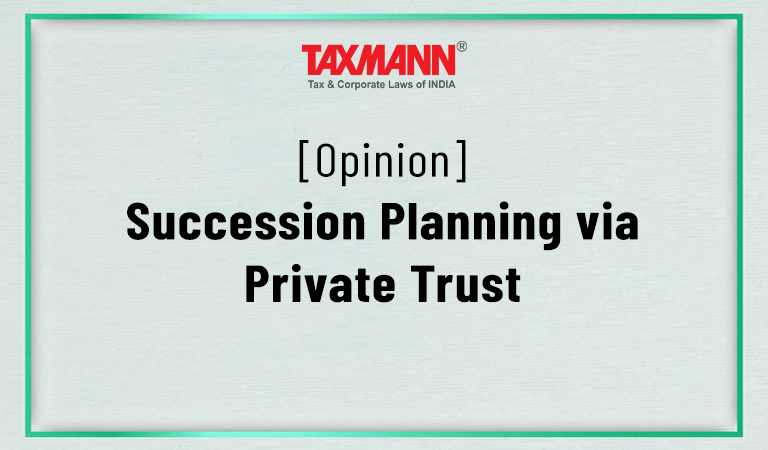[Opinion] Succession Planning via Private Trust
- Blog|News|Income Tax|
- 3 Min Read
- By Taxmann
- |
- Last Updated on 29 November, 2022
Anjul Mathur & Deepak Sharma – [2022] 145 taxmann.com 159 (Article)
1. Introduction
India has been a family-run economy. Families run large, medium, and small businesses very successfully, providing significant employment as well as returns to stakeholders. Many of these corporations have listed their shares on stock exchanges, allowing the general public to share in their profits.
Families have amassed significant wealth over the last few decades, and succession is always a concern for the patriarch of the family. Many times, wealth protection is more important than increased profits. In addition to the economic succession of the family’s assets (financial and business assets), management succession (handing over the reins of the business to family members or professionals) is an important part of any succession planning.
Effective estate and wealth planning ensures that families retain control of their businesses and that leadership of businesses is transferred smoothly between generations of families. It strikes a balance between the needs of businesses and the interests of family members. Effective wealth planning for high-net-worth individuals can avoid lengthy and costly legal battles between heirs based in multiple jurisdictions. Various structures provide varying degrees of control over the purpose for which wealth can be used and how it can be used. The private family trust is one of the most commonly used structures for managing personal assets, including both tangible and intellectual property, and succession planning.
This article focuses on estate and wealth succession via a ‘Private Trust’ mechanism.
2. Private Trust
As previously stated, one of the most commonly used structures for managing personal assets, including both tangible and intellectual property, and succession planning is the private family trust.
Private Trusts are governed by the provisions of the Indian Trust Act, 1882 (‘Trust Act’). Trusts with a public character are not administered by the Trust Act, instead the particular State Public Trust Act would be the applicable law. Example: Bombay Public Trust Act, 1950, Punjab Trust Act, 1950.
As per the Trust Act, a trust is ‘as an obligation annexed to the ownership of property, and arising out of a confidence reposed in and accepted by the owner, or declared or accepted by him, for the benefit of another, or of another and the owner.’
The person who reposes or declares the confidence is called the “author of the trust” (commonly referred to as a ‘settlor’). The person who accepts the confidence is called the “trustee”. The person for whose benefit the confidence is accepted is called the “beneficiary”. The subject matter of the trust is called “trust property”. The “beneficial interest” or “interest” of the beneficiary is the right against the trustee as owner of the trust property. The instrument, if any, by which the trust is declared is called the “instrument of trust” (commonly known as the ‘trust deed’ or ‘indenture of trust’).
A private trust offers several advantages, including
- Efficient mode of managing and passing the family assets as it helps create a legal framework for the family assets.
- Bypasses the probate process which is susceptible to frivolous claims and delays in the court process.
- Safeguards interests of family members including maintenance of members with special needs/disabilities.
- Possible to attach conditions to gifts such as on attaining a particular age or fulfilment of the settlor’ wishes
- Avoids family disputes over the property
- Helps structure business succession which may be based on a balance of merit and family control, and facilitate philanthropic activities.
In addition to the above-mentioned essential components of a trust, a trust structure may also include a Protector and/or Trust Advisor. The Protector of a trust is a trusted individual, generally known to the family, who advises the trustee in various circumstances. His primary role is to ensure that the views of the family are represented, especially in cases where the trustees may be a non-family member, an institution, or a private trust company. However, the ultimate decision with respect to any trust matter remains with the trustee or in some cases with the Settlor depending on the structure of the trust.
Click Here To Read The Full Article
Disclaimer: The content/information published on the website is only for general information of the user and shall not be construed as legal advice. While the Taxmann has exercised reasonable efforts to ensure the veracity of information/content published, Taxmann shall be under no liability in any manner whatsoever for incorrect information, if any.

Taxmann Publications has a dedicated in-house Research & Editorial Team. This team consists of a team of Chartered Accountants, Company Secretaries, and Lawyers. This team works under the guidance and supervision of editor-in-chief Mr Rakesh Bhargava.
The Research and Editorial Team is responsible for developing reliable and accurate content for the readers. The team follows the six-sigma approach to achieve the benchmark of zero error in its publications and research platforms. The team ensures that the following publication guidelines are thoroughly followed while developing the content:
- The statutory material is obtained only from the authorized and reliable sources
- All the latest developments in the judicial and legislative fields are covered
- Prepare the analytical write-ups on current, controversial, and important issues to help the readers to understand the concept and its implications
- Every content published by Taxmann is complete, accurate and lucid
- All evidence-based statements are supported with proper reference to Section, Circular No., Notification No. or citations
- The golden rules of grammar, style and consistency are thoroughly followed
- Font and size that’s easy to read and remain consistent across all imprint and digital publications are applied








 CA | CS | CMA
CA | CS | CMA


